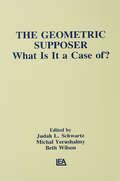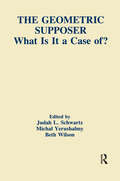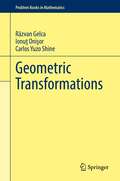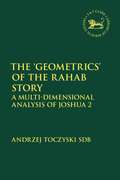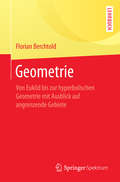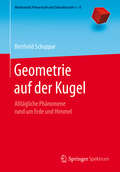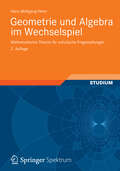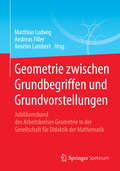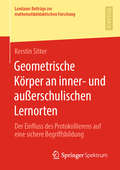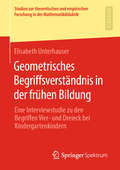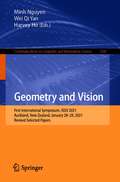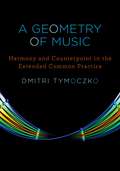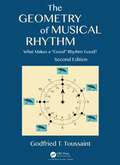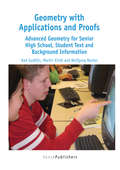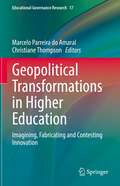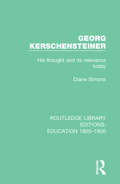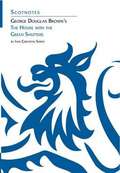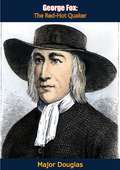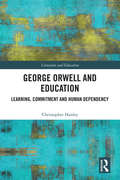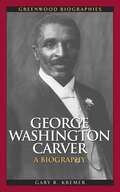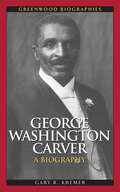- Table View
- List View
The Geometric Supposer: What Is It A Case Of? (Technology and Education Series)
by Judah L. Schwartz Michal Yerushalmy Beth WilsonThis volume is a case study of education reform and innovation using technology that examines the issue from a wide variety of perspectives. It brings together the views and experiences of software designers, curriculum writers, teachers and students, researchers and administrators. Thus, it stands in contrast to other analyses of innovation that tend to look through the particular prisms of research, classroom practice, or software design. The Geometric Supposer encourages a belief in a better tomorrow for schools. On its surface, the Geometric Supposer provides the means for radically altering the way in which geometry is taught and the quality of learning that can be achieved. At a deeper level, however, it suggests a powerful metaphor for improving education that can be played out in many different instructional contexts.
The Geometric Supposer: What Is It A Case Of? (Technology and Education Series)
by Judah L. Schwartz Michal Yerushalmy Beth WilsonThis volume is a case study of education reform and innovation using technology that examines the issue from a wide variety of perspectives. It brings together the views and experiences of software designers, curriculum writers, teachers and students, researchers and administrators. Thus, it stands in contrast to other analyses of innovation that tend to look through the particular prisms of research, classroom practice, or software design. The Geometric Supposer encourages a belief in a better tomorrow for schools. On its surface, the Geometric Supposer provides the means for radically altering the way in which geometry is taught and the quality of learning that can be achieved. At a deeper level, however, it suggests a powerful metaphor for improving education that can be played out in many different instructional contexts.
Geometric Transformations (Problem Books in Mathematics)
by Răzvan Gelca Ionuţ Onişor Carlos Yuzo ShineThis textbook teaches the transformations of plane Euclidean geometry through problems, offering a transformation-based perspective on problems that have appeared in recent years at mathematics competitions around the globe, as well as on some classical examples and theorems. It is based on the combined teaching experience of the authors (coaches of several Mathematical Olympiad teams in Brazil, Romania and the USA) and presents comprehensive theoretical discussions of isometries, homotheties and spiral similarities, and inversions, all illustrated by examples and followed by myriad problems left for the reader to solve. These problems were carefully selected and arranged to introduce students to the topics by gradually moving from basic to expert level. Most of them have appeared in competitions such as Mathematical Olympiads or in mathematical journals aimed at an audience interested in mathematics competitions, while some are fundamental facts of mathematics discussed in the framework of geometric transformations. The book offers a global view of the geometric content of today's mathematics competitions, bringing many new methods and ideas to the attention of the public.Talented high school and middle school students seeking to improve their problem-solving skills can benefit from this book, as well as high school and college instructors who want to add nonstandard questions to their courses. People who enjoy solving elementary math problems as a hobby will also enjoy this work.
The ‘Geometrics’ of the Rahab Story: A Multi-Dimensional Analysis of Joshua 2 (The Library of Hebrew Bible/Old Testament Studies)
by Andrzej Toczyski SdbExamines the dialectic relationship between the text, conceived as the vehicle of narrative communication, and the reader in an assemenent of the story of Rahab – the prostitute from Jericho – in Josuha 2. Toczyski uses his study to examine how this story has been read by various audiences across time, the different interpretive perspectives and methodologies that have thus been brought to the text and the influences this has had on the manner in which the story has been interpreted. In particular Toczyski focuses on internal literary analysis of Joshua 2 and the external historical approach and what this can say about the readers of the text. The purpose of such insight is to register how successive interpretations overlap and set the interpretative pattern for subsequent generations of readers. As a result of this conceptual framework, Toczyski presents the Rahab story in the broader context of the communicative process, which has been challenging the story's readers for centuries. This deep immersion into both internal and external contexts reveals the generally-overlooked thread within the Rahab story, namely “the power of storytelling”, which may prove relevant for contemporary readers by providing grounds for inter-cultural dialogue in the postmodern world.
Geometrie: Von Euklid bis zur hyperbolischen Geometrie mit Ausblick auf angrenzende Gebiete
by Florian BerchtoldDieses Buch bietet Ihnen einen übersichtlichen, umfassenden und klar verständlichen Einblick in die elementare Geometrie und verwandte Gebiete. Sie finden darin alles, was Sie zur Vorbereitung auf Bachelor- oder Staatsexamensprüfungen im Rahmen der Geometrie benötigen. Auch als Nachschlagewerk für Mathematiklehrer und alle in und mit der Mathematik arbeitenden oder an der Mathematik interessierten Personen ist es bestens geeignet. Neben der aus der Schule bekannten euklidischen Geometrie finden Sie unter Anderem Einblicke in nichteuklidische Geometrien, Konvexgeometrie, diskrete Geometrie sowie topologische Geometrie. Durch eine Reihe von im Text eingestreuten, das Verständnis vertiefenden Übungsaufgaben können Sie den Stoff problemlos im Selbststudium erarbeiten.
Geometrie auf der Kugel: Alltägliche Phänomene rund um Erde und Himmel (Mathematik Primarstufe und Sekundarstufe I + II)
by Berthold SchupparIn diesem Buch werden wesentliche Fragen der elementaren Geometrie auf der Kugeloberfläche und ihre Anwendungen auf die Erd- und Himmelskugel (mathematische Geografie und Astronomie) so aufgegriffen und beantwortet, dass sie als Hintergrundwissen für einen realitätsnahen Geometrieunterricht in der Sekundarstufe zur Verfügung stehen. Im Mittelpunkt stehen alltägliche Phänomene (wie z. B. geografische Koordinaten, Kompass, kürzeste Wege, Sonnenlauf, Zeit, Weltkarten), sodass Studierende im Sinne Freudenthals „nicht angewandte Mathematik lernen, sondern Mathematik anwenden lernen“. Reflexionen zur Modellierung sowie historische Aspekte runden die Betrachtungen ab. Die Theorie wird nur so weit entwickelt, wie es für diese Ziele erforderlich ist. Digitale Werkzeuge werden dort eingesetzt, wo es notwendig und sinnvoll erscheint. Jedes Kapitel bietet eine reichhaltige Aufgabensammlung.
Geometrie und Algebra im Wechselspiel: Mathematische Theorie für schulische Fragestellungen
by Hans-Wolfgang HennDiese 2., überarbeitete und erweiterte Auflage des bisher unter dem Titel „Elementare Geometrie und Algebra“ erschienenen Lehrbuches weist deutlicher auf die angestrebte Vernetzung der Mathematik in Schule und Hochschule hin. In dem neuen ersten Kapitel wird die „Philosophie“ des Buches mit seinen zentralen didaktischen Prinzipien dargestellt. In jedem der folgenden fünf Kapitel wird zunächst im ersten Abschnitt ausführlich die Wechselwirkung der jeweiligen Thematik mit dem schulischen Mathematikunterricht dargestellt. Der dann folgende mathematische Inhalt der Kapitel ist im Wesentlichen eine Überarbeitung der Kapitel der ersten Auflage. Dieses Buch setzt eine gewisse „mathematische Grundbildung“ voraus, wie sie z. B. in den ersten zwei mathematischen Studiensemestern erworben wird. Die Kapitel sind unabhängig voneinander lesbar, möglichst oft wurden historische Zusammenhänge eingearbeitet und auch passende interessante mathematische Anekdoten erwähnt.
Geometrie zwischen Grundbegriffen und Grundvorstellungen: Jubiläumsband des Arbeitskreises Geometrie in der Gesellschaft für Didaktik der Mathematik
by Matthias Ludwig Andreas Filler Anselm LambertMathematische Grundvorstellungen sind im Bereich der Arithmetik und Algebra umfassend bearbeitet worden, für die Geometrie gilt dies bislang nicht. Dieser Band beleuchtet erste wesentliche Schritte in diese Richtung und versucht die fehlenden Konzepte der Grundvorstellungen in der Geometriedidaktik aufzuarbeiten. In engem Zusammenhang mit Grundvorstellungen stehen Begriffsbildungen, denen ein hoher Stellenwert im Geometrieunterricht zukommt. Das Buch enthält die ausformulierten Vorträge der 30. Herbsttagung 2013 des Arbeitskreis Geometrie in der Gesellschaft für Didaktik der Mathematik (GDM).
Geometrische Körper an inner- und außerschulischen Lernorten: Der Einfluss des Protokollierens auf eine sichere Begriffsbildung (Landauer Beiträge zur mathematikdidaktischen Forschung)
by Kerstin SitterGeometrische Körper gehören nicht zu den leicht verständlichen Inhalten des Geometrieunterrichts, insbesondere durch die Dreidimensionalität muss von den Lernenden vielfach räumliches Vorstellungsvermögen eingebracht werden. Inhalte zu geometrischen Körpern sind daher besonders eng mit einem Umweltbezug verbunden. Kerstin Sitter untersucht, wie an außerschulischen Lernorten Wissen zu Körpern generiert wird und im Klassenzimmer nachhaltig aufbereitet bzw. reflektiert werden kann. Als Anhaltspunkt und Richtschnur wird das Niveaustufen-Modell von Pierre und Dina van Hiele genutzt. Im Hinblick auf die Unterstützung von selbstständigkeitsorientierten Lernprozessen liegt ein weiterer Schwerpunkt der Studie auf der Erfassung grundlegender Protokollierfähigkeiten. Durch den gezielten Einsatz elementarer Grundhandlungen, dem Identifizieren und Realisieren sowie der Sprachhandlungen Beschreiben und Begründen gelingt es der Autorin, eine nachhaltige Begriffsbildung zu erreichen, wie die Untersuchungsergebnisse eindrucksvoll belegen.
Geometrisches Begriffsverständnis in der frühen Bildung: Eine Interviewstudie zu den Begriffen Vier- und Dreieck bei Kindergartenkindern (Studien zur theoretischen und empirischen Forschung in der Mathematikdidaktik)
by Elisabeth UnterhauserElisabeth Unterhauser untersucht ausgehend von umfassenden theoretischen Überlegungen mittels einer Interviewstudie mit 120 Kindern zwischen vier und sechs Jahren frühe geometrische Begriffsbildungsprozesse. Sie kombiniert Forschungsansätze entsprechend des Mixed-Methods-Designs und entwickelt eine neue Art der Analyse kindlicher Begründungen, die zeigt, dass das Verständnis der Begriffe Vier- und Dreieck bereits im Elementarbereich sehr heterogen ist. Für beide Begriffe ermittelt die Autorin statistisch inhaltlich ähnliche Begriffsverständnistypen, die als Orientierung für die didaktische Gestaltung anschlussfähiger Begriffsbildungsprozesse im Elementarbereich sowie als Diagnoseinstrument genutzt werden können.
Geometry and Vision: First International Symposium, ISGV 2021, Auckland, New Zealand, January 28-29, 2021, Revised Selected Papers (Communications in Computer and Information Science #1386)
by Minh Nguyen Wei Qi Yan Harvey HoThis book constitutes selected papers from the First International Symposium on Geometry and Vision, ISGV 2021, held in Auckland, New Zealand, in January 2021. Due to the COVID-19 pandemic the conference was held in partially virtual format. The 29 papers were thoroughly reviewed and selected from 50 submissions. They cover topics in areas of digital geometry, graphics, image and video technologies, computer vision, and multimedia technologies.
A Geometry of Music: Harmony and Counterpoint in the Extended Common Practice (Oxford Studies in Music Theory)
by Dmitri TymoczkoHow is the Beatles' "Help!" similar to Stravinsky's "Dance of the Adolescents?" How does Radiohead's "Just" relate to the improvisations of Bill Evans? And how do Chopin's works exploit the non-Euclidean geometry of musical chords? In this groundbreaking work, author Dmitri Tymoczko describes a new framework for thinking about music that emphasizes the commonalities among styles from medieval polyphony to contemporary rock. Tymoczko identifies five basic musical features that jointly contribute to the sense of tonality, and shows how these features recur throughout the history of Western music. In the process he sheds new light on an age-old question: what makes music sound good? A Geometry of Music provides an accessible introduction to Tymoczko's revolutionary geometrical approach to music theory. The book shows how to construct simple diagrams representing relationships among familiar chords and scales, giving readers the tools to translate between the musical and visual realms and revealing surprising degrees of structure in otherwise hard-to-understand pieces. Tymoczko uses this theoretical foundation to retell the history of Western music from the eleventh century to the present day. Arguing that traditional histories focus too narrowly on the "common practice" period from 1680-1850, he proposes instead that Western music comprises an extended common practice stretching from the late middle ages to the present. He discusses a host of familiar pieces by a wide range of composers, from Bach to the Beatles, Mozart to Miles Davis, and many in between. A Geometry of Music is accessible to a range of readers, from undergraduate music majors to scientists and mathematicians with an interest in music. Defining its terms along the way, it presupposes no special mathematical background and only a basic familiarity with Western music theory. The book also contains exercises designed to reinforce and extend readers' understanding, along with a series of appendices that explore the technical details of this exciting new theory.
A Geometry of Music: Harmony and Counterpoint in the Extended Common Practice (Oxford Studies in Music Theory)
by Dmitri TymoczkoHow is the Beatles' "Help!" similar to Stravinsky's "Dance of the Adolescents?" How does Radiohead's "Just" relate to the improvisations of Bill Evans? And how do Chopin's works exploit the non-Euclidean geometry of musical chords? In this groundbreaking work, author Dmitri Tymoczko describes a new framework for thinking about music that emphasizes the commonalities among styles from medieval polyphony to contemporary rock. Tymoczko identifies five basic musical features that jointly contribute to the sense of tonality, and shows how these features recur throughout the history of Western music. In the process he sheds new light on an age-old question: what makes music sound good? A Geometry of Music provides an accessible introduction to Tymoczko's revolutionary geometrical approach to music theory. The book shows how to construct simple diagrams representing relationships among familiar chords and scales, giving readers the tools to translate between the musical and visual realms and revealing surprising degrees of structure in otherwise hard-to-understand pieces. Tymoczko uses this theoretical foundation to retell the history of Western music from the eleventh century to the present day. Arguing that traditional histories focus too narrowly on the "common practice" period from 1680-1850, he proposes instead that Western music comprises an extended common practice stretching from the late middle ages to the present. He discusses a host of familiar pieces by a wide range of composers, from Bach to the Beatles, Mozart to Miles Davis, and many in between. A Geometry of Music is accessible to a range of readers, from undergraduate music majors to scientists and mathematicians with an interest in music. Defining its terms along the way, it presupposes no special mathematical background and only a basic familiarity with Western music theory. The book also contains exercises designed to reinforce and extend readers' understanding, along with a series of appendices that explore the technical details of this exciting new theory.
The Geometry of Musical Rhythm: What Makes a "Good" Rhythm Good?, Second Edition
by Godfried T. ToussaintThe original edition of The Geometry of Musical Rhythm was the first book to provide a systematic and accessible computational geometric analysis of the musical rhythms of the world. It explained how the study of the mathematical properties of musical rhythm generates common mathematical problems that arise in a variety of seemingly disparate fields. The book also introduced the distance approach to phylogenetic analysis and illustrated its application to the study of musical rhythm. The new edition retains all of this, while also adding 100 pages, 93 figures, 225 new references, and six new chapters covering topics such as meter and metric complexity, rhythmic grouping, expressive timbre and timing in rhythmic performance, and evolution phylogenetic analysis of ancient Greek paeonic rhythms. In addition, further context is provided to give the reader a fuller and richer insight into the historical connections between music and mathematics.
The Geometry of Musical Rhythm: What Makes a "Good" Rhythm Good?, Second Edition
by Godfried T. ToussaintThe original edition of The Geometry of Musical Rhythm was the first book to provide a systematic and accessible computational geometric analysis of the musical rhythms of the world. It explained how the study of the mathematical properties of musical rhythm generates common mathematical problems that arise in a variety of seemingly disparate fields. The book also introduced the distance approach to phylogenetic analysis and illustrated its application to the study of musical rhythm. The new edition retains all of this, while also adding 100 pages, 93 figures, 225 new references, and six new chapters covering topics such as meter and metric complexity, rhythmic grouping, expressive timbre and timing in rhythmic performance, and evolution phylogenetic analysis of ancient Greek paeonic rhythms. In addition, further context is provided to give the reader a fuller and richer insight into the historical connections between music and mathematics.
Geometry with Applications and Proofs: Advanced Geometry for Senior High School,Student Text and Background Information (Dutch Design in Mathematics Education #0)
by Aad Goddijn Martin Kindt Wolfgang ReuterThis book shows how geometry can be learned by starting with real world problems which are solved by intuition, common sense reasoning and experiments. Gradually the more formal demands of mathematical proofs get their proper place and make it possible to explore new applications. This process helps students to feel the need for precise definitions and procedures, to contribute to the construction of an axiomatic system, and to experience the power of systematic reasoning.The course is designed for students in a Nature & Technology strand which prepares for studying the sciences or technology at university level. Its goal was basically to reintroduce ‘proof’ in a meaningful way in the late 1990s Dutch secondary education curriculum. Following the educational view of the Freudenthal Institute this is not done by stating Euclid’s axioms on page one, but rather a starting point is chosen in students’ intuitions and tentative solutions of problems that are experienced as real and relevant.The photograph on the cover shows students exploring one of the problems from the midpart of the course in the computerlab.
Geopolitical Transformations in Higher Education: Imagining, Fabricating and Contesting Innovation (Educational Governance Research #17)
by Marcelo Parreira do Amaral Christiane ThompsonThis book discusses the central role education and research play in generating both value and comparative advantages in the (imageries of) global competition, competitiveness and transnational value chains. They are seen as assets placed at the forefront of developments that are arguably reshaping individuals, society and economy. This edited volume explores these developments in terms of changing relations between society, economy, science and individuals. The idea that we live in global knowledge societies and knowledge-based economies or that present-day productive systems constitute an industry 4.0 have gained currency as descriptions of contemporary society that are said to bear direct and indirect consequences for political, economic, and social orders. In this context, innovation, science and education are central themes in contemporary discussions about the future of modern societies. Innovation is enthusiastically embraced as the panacea for all sorts of societal issues of our times; science is equally deemed to play a decisive role in solving current problems and in heralding a bright future with more wealth and more welfare for all citizens; education is conferred the task to producing individuals equipped with both skills and competences considered key to innovation but also displaying the attitudes and dispositions that will secure continuous innovation and economic growth.
Georg Kerschensteiner: His Thought and its Relevance Today (Routledge Library Editions: Education 1800-1926)
by Diane SimonsThis book, first published in 1966, is an introduction to the life and work of Georg Kerschensteiner, the pioneer of the modern German system of vocational education, a system which is largely responsible for Germany’s remarkable industrial recovery and advancement after the Second World War. This title will be of interest to students of education and history.
Georg Kerschensteiner: His Thought and its Relevance Today (Routledge Library Editions: Education 1800-1926)
by Diane SimonsThis book, first published in 1966, is an introduction to the life and work of Georg Kerschensteiner, the pioneer of the modern German system of vocational education, a system which is largely responsible for Germany’s remarkable industrial recovery and advancement after the Second World War. This title will be of interest to students of education and history.
George Douglas Brown's The House with the Green Shutters (Scotnotes Ser. No. 3)
by Iain Crichton SmithThe House with the Green Shutters is a dark, provocative novel, shining a harsh and unforgiving light into the inner recesses of small-town Scotland at the turn of the last century. Written as a response to social change, and as an antidote to the sentimentality of the ‘Kailyard’ school, the author called it “a brutal and bloody work” – although a thread of sly humour runs through the book as well. Iain Crichton Smith’s Scotnote explores this post-romantic masterpiece through a precise analysis of themes, characters, structure and language, and is ideal for senior school pupils and students.
George Fox: The Red-Hot Quaker
by Major DouglasThe story of George Fox’s life suffers from two great disadvantages which the reader should always bear in mind.In the first place, the old, strange, stilted language, used by all in his day, makes it difficult for us to feel as much at home with him as we should do. We must remember that even Salvationists in our own days are tempted when they write to give up their simple, everyday language, and to wrap up their thoughts more fashionably. But those who will try to see George Fox, as he so often was to be found, praising the Lord in a stinking prison cell, will be able in spite of his strange words to grasp his glorious meaning.And then we have also to remind ourselves that he had little chance either to observe or to organize any regular and effective warfare. For over a hundred years England had been victimized by religious discussions until the very idea of real worship had been almost lost. No wonder at poor George’s perplexities when his hungry soul began to long for God, and no wonder that the great note of his whole life thereafter was so largely that of avoiding whatever others did. If he could anywhere have seen how singing processions, flags, music, open-air demonstrations could be used in the power of the Holy Ghost to the salvation of the people; and if he could have been allowed to organize accordingly, all England would have been stirred and perhaps delivered at once from the curses of formalism and spiritual death. But it may be that God only granted him light according to what it was then possible to do. He lived a prophet’s life leaving to us in these days of liberty, not a complete description of our duties, but an example of fearless, devoted service, that, alas, but few have ever attempted to follow.
George Orwell and Education: Learning, Commitment and Human Dependency (Literature and Education)
by Christopher HanleyGeorge Orwell and Education uses Orwell’s life and works to address current educational questions. His early life, political awakening and artistic development are key elements in the book’s presentation of Orwell himself as a learner, and as someone whose ideas continue to speak to contemporary debates about human interdependency. The focus of the book is on critical issues in education, including the idea of universality, the status of young people and the nature of learning. Orwell’s efforts to conceptualise, and artistically realise his own experience, create a platform for exploring current educational issues in their philosophical and political contexts. This book will encourage a reimagining of, and stimulate debate about an idea of education that is less individualistic, pays greater attention to human mutuality, is politically engaged and ultimately more sustainable. The book will appeal to researchers, scholars and post-graduate students in the fields of literature in education, pedagogy, educational philosophy, literary theory, citizenship and youth and community.
George Orwell and Education: Learning, Commitment and Human Dependency (Literature and Education)
by Christopher HanleyGeorge Orwell and Education uses Orwell’s life and works to address current educational questions. His early life, political awakening and artistic development are key elements in the book’s presentation of Orwell himself as a learner, and as someone whose ideas continue to speak to contemporary debates about human interdependency. The focus of the book is on critical issues in education, including the idea of universality, the status of young people and the nature of learning. Orwell’s efforts to conceptualise, and artistically realise his own experience, create a platform for exploring current educational issues in their philosophical and political contexts. This book will encourage a reimagining of, and stimulate debate about an idea of education that is less individualistic, pays greater attention to human mutuality, is politically engaged and ultimately more sustainable. The book will appeal to researchers, scholars and post-graduate students in the fields of literature in education, pedagogy, educational philosophy, literary theory, citizenship and youth and community.
George Washington Carver: A Biography (Greenwood Biographies)
by Gary R. KremerThis book strips away the myths surrounding the famed scientist George Washington Carver and portrays him as a brilliant, creative man who nonetheless possessed very human peculiarities and frailties.This insightful work chronicles the life of George Washington Carver, the renowned African American scientist and teacher. George Washington Carver: A Biography begins with a discussion of the political and social circumstances in Missouri where Carver was born into slavery, circa 1864. Readers will follow Carver through his formal education to his decision to accept Booker T. Washington's offer to teach and do research at the Tuskegee Institute in Alabama.The bulk of the volume focuses on Carver's career at Tuskegee, a career that spanned nearly five decades, from 1896 until Carver's death in January 1943.The book highlights Carver's major achievements, including his championing of crop rotation and the hundreds of products he created from peanuts, sweet potatoes, and other plants native to the South. In addition to Carver the scientist, students will meet Carver the man, who, for example, loved art and painted throughout his life.
George Washington Carver: A Biography (Greenwood Biographies)
by Gary R. KremerThis book strips away the myths surrounding the famed scientist George Washington Carver and portrays him as a brilliant, creative man who nonetheless possessed very human peculiarities and frailties.This insightful work chronicles the life of George Washington Carver, the renowned African American scientist and teacher. George Washington Carver: A Biography begins with a discussion of the political and social circumstances in Missouri where Carver was born into slavery, circa 1864. Readers will follow Carver through his formal education to his decision to accept Booker T. Washington's offer to teach and do research at the Tuskegee Institute in Alabama.The bulk of the volume focuses on Carver's career at Tuskegee, a career that spanned nearly five decades, from 1896 until Carver's death in January 1943.The book highlights Carver's major achievements, including his championing of crop rotation and the hundreds of products he created from peanuts, sweet potatoes, and other plants native to the South. In addition to Carver the scientist, students will meet Carver the man, who, for example, loved art and painted throughout his life.
